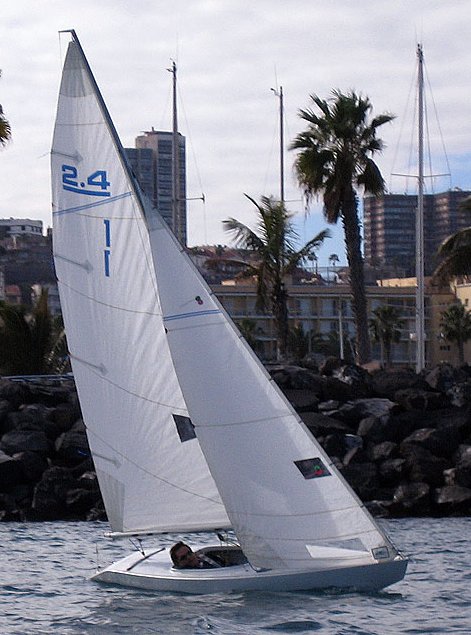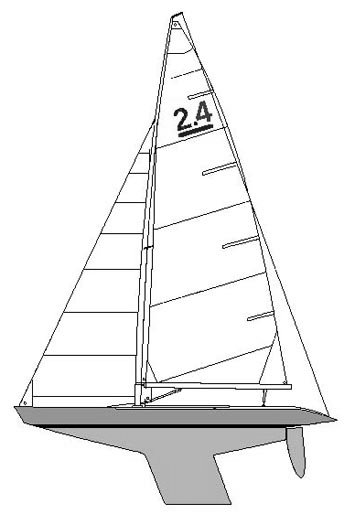2.4 METER - sailboatdata (original) (raw)


| Hull Type: | Fin w/spade rudder |
|---|---|
| Rigging Type: | Fractional Sloop |
| LOA: | 13.50 ft / 4.11 m |
| LWL: | 12.00 ft / 3.66 m |
| S.A. (reported): | 80.00 ft² / 7.43 m² |
| Beam: | 2.65 ft / 0.81 m |
| Displacement: | 600.00 lb / 272 kg |
| Ballast: | 350.00 lb / 159 kg |
| Max Draft: | 3.25 ft / 0.99 m |
| Construction: | FG |
| Ballast Type: | Lead |
| First Built: | 1986 |
| Builder: | Various |
| Designer: | Various |
| S.A. / Displ.: | 18.02 |
|---|---|
| Bal. / Displ.: | 58.33 |
| Disp: / Len: | 155.01 |
| Comfort Ratio: | 20.28 |
| Capsize Screening Formula: | 1.26 |
| Hull Speed: | 4.64 kn |
| Pounds/Inch Immersion: | 113.62 pounds/inch |
Sailboat Links
Notes
As this is a development class, dimensions are approximate. See class association website for further information.
Sailboat Forum
Calculations Help
SA/Disp.:
A sail area/displacement ratio below 16 would be considered under powered;
16 to 20 would indicate reasonably good performance;
above 20 suggests relatively high performance.
SA/D = SA (ft²) ÷ [Disp (lbs) / 64]^.666
Bal./Disp.:
A Ballast/Displacement ratio of 40 or more translates into a stiffer, more powerful boat that will be better able to stand up to the wind.
Bal./Disp = ballast (lbs)/ displacement (lbs)*100
Disp./Len.:
The lower a boat’s Displacement/Length (LWL) ratio, the less power it takes to drive the boat to its nominal hull speed.
less than 100 = Ultralight;
100-200 = Light;
200-275 = Moderate;
275-350 = Heavy;
350+ = Ultraheavy;
D/L = (Disp / 2240) / (0.01*LWL)^3.
Comfort Ratio:
This is a ratio created by Ted Brewer as a measure of motion comfort. It provides a reasonable comparison between yachts of similar size and type. It is based on the fact that the faster the motion the more upsetting it is to the average person. Consider, though, that the typical summertime coastal cruiser will rarely encounter the wind and seas that an ocean going yacht will meet.
Numbers below 20 indicate a lightweight racing boat, small dinghy and such;
20 to 30 indicates a coastal cruiser;
30 to 40 indicates a moderate bluewater cruising boat;
40 to 50 indicates a heavy bluewater boat;
over 50 indicates an extremely heavy bluewater boat.
Comfort ratio = D ÷ (.65 x (.7 LWL + .3 LOA) x Beam^1.33), where displacement is expressed in pounds, and length is expressed in feet.
Capsize Screening Formula (CSF):
Designed to determine if a boat has blue water capability. The CSF compares beam with displacement since excess beam contributes to capsize and heavy displacement reduces capsize vulnerability. The boat is better suited for ocean passages (vs coastal cruising) if the result of the calculation is 2.0 or less. The lower the better.
CSF = Beam/Disp (cubic ft)^.333. The displacement in cubic feet can be found by dividing the displacement in pounds by 64.
S#:
S# first appeared (that we know of) in TellTales, April 1988, “On a Scale of One to Ten” by A.P. Brooks . The equation incorporates SA/Disp (100% fore triangle) and Disp/length ratios to create a guide to probable boat performance vs. other boats of comparable size. For boats of the same length, generally the higher the S#, the lower the PHRF.
Under 2 – Slow, under powered.
2-3 – Cruiser
3-5 – Racer Cruiser
5+ – Fast/Racing
S# = 3.972*(10^(-[@[Dsp/LWL]]/526+(0.691*(LOG([@[SA/Dp]])-1)^0.8)))
Hull Speed:
The maximum speed of a displacement hull (referring to a hull that travels through the water rather than on top of it, e.g. planing).
HS = 1.34 x √LWL (in feet)
Pounds per Inch Immersion:
The weight required to sink the yacht one inch. Calculated by multiplying the LWL area by 5.333 for sea water or 5.2 for fresh water.
FOR MULTIHULLS ONLY:
BN – Bruce Number: The Bruce Number is a power-to-weight ratio for relative speed potential for comparing two or more boats. It takes into consideration the displacement and sail area of main and jib. 100% fore-triangle only, no overlapping sails.
Chris White, “The Cruising Multihull”, (International Marine, Camden, Maine, 1997), states that a boat with a BN of less than 1.3 will be slow in light winds. A boat with a BN of 1.6 or greater is a boat that will be reefed often in offshore cruising.
Derek Harvey, “Multihulls for Cruising and Racing”, International Marine, Camden, Maine, 1991, states that a BN of 1 is generally accepted as the dividing line between so-called slow and fast multihulls.
BN = SA^0.5/(Disp. in pounds)^.333
Kelsall Sailing Performance (KSP): Another measure of relative speed potential of a boat. It takes into consideration “reported” sail area, displacement and length at waterline. The higher the number the faster speed prediction for the boat. A cat with a number 0.6 is likely to sail 6kts in 10kts wind, a cat with a number of 0.7 is likely to sail at 7kts in 10kts wind.
KSP = (Lwl*SA÷D)^0.5*0.5
Specifications Help
LENGTH: Traditionally, LOA (length over all) equaled hull length. Today, many builders use LOA to include rail overhangs, bowsprits, etc. and LOD (length on deck) for hull length. That said, LOA may still mean LOD if the builder is being honest and using accepted industry standards developed by groups like the ABYC (American Boat and Yacht Council).
It is often difficult for us to know which use of LOA the builder is reporting.
As a result, we use LOA as reported by the builder regardless of whether it includes overhangs or not.
When we know, we use LOA to include overhangs and LOD for hull length.
LENGTH WATERLINE (LWL): LWL is the length of the hull at the level where it sits in the water (the waterline) as measured from the bow ending at the waterline to the stern ending. The LWL will increase as the yacht sinks into the water with the added weight of stores and equipment.
BEAM: This is the greatest width of the hull and is often expressed as Beam (Max). Beam WL: Greatest width of the hull at the waterline.
DRAFT: This is the depth of the hull from the LWL to the bottom of the keel or fin. Like the LWL, it will vary with the weights of fuel, water, stores and equipment. A boat’s actual draft is usually somewhat more than the original designed or advertised draft. For boats with adjustable keels (centerboards, daggerboards, lifting and swing keels), Draft (max) is with the board down. Draft (min) is with the board up.
DISPLACEMENT: If you weigh the boat on a scale, that is her actual displacement. It is the weight of sea water that she will displace when she is afloat. Many designers figure displacement when half loaded with stores, liquids and crew. Some report light displacement which is the weight of the hull and permanent equipment but with empty tanks. Light displacement does not include stores, removable equipment (ex. Sails) or crew.
GROSS/NET TONNAGE (GRT/NRT): Not a measure of the ship’s weight or displacement, gross tonnage is a ship’s total internal volume expressed in “register tons (GRT)”, each of which is equal to 100 cubic feet (2.83 cubic meters or 748 US Gallons). Net tonnage (NRT) refers to usable space by subtracting from gross tonnage the volume of spaces such as engine rooms, fuel tanks and crew quarters. It reflects the remaining space available to accommodate passengers and cargo.
BALLAST: Material that is placed low in a vessel to improve its stability. Commonly used materials are (but not limited to) lead, iron, water (which can be added or removed via tanks) and/or concrete.
S.A.: Sail Area. The total combined area of the sails when sailing upwind. S.A. (reported) is the area reported by the builder. (Verses ** S.A. (100% Fore + Main Triangles) which is the area as defined by the rig measurements.) S.A. (reported) can differ depending on the size of the head sail used to calculate the S.A.
Sailboat Rigging Diagram

